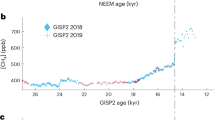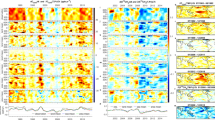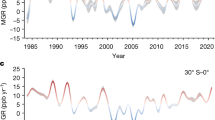Abstract
Considerable debate surrounds the source of the apparently ‘anomalous’1 increase of atmospheric methane concentrations since the mid-Holocene (5,000 years ago) compared to previous interglacial periods as recorded in polar ice core records2. Proposed mechanisms for the rise in methane concentrations relate either to methane emissions from anthropogenic early rice cultivation1,3 or an increase in natural wetland emissions from tropical4 or boreal sources5,6. Here we show that our climate and wetland simulations of the global methane cycle over the last glacial cycle (the past 130,000 years) recreate the ice core record and capture the late Holocene increase in methane concentrations. Our analyses indicate that the late Holocene increase results from natural changes in the Earth's orbital configuration, with enhanced emissions in the Southern Hemisphere tropics linked to precession-induced modification of seasonal precipitation. Critically, our simulations capture the declining trend in methane concentrations at the end of the last interglacial period (115,000–130,000 years ago) that was used to diagnose the Holocene methane rise as unique. The difference between the two time periods results from differences in the size and rate of regional insolation changes and the lack of glacial inception in the Holocene. Our findings also suggest that no early agricultural sources are required to account for the increase in methane concentrations in the 5,000 years before the industrial era.
This is a preview of subscription content, access via your institution
Access options
Subscribe to this journal
Receive 51 print issues and online access
$199.00 per year
only $3.90 per issue
Buy this article
- Purchase on Springer Link
- Instant access to full article PDF
Prices may be subject to local taxes which are calculated during checkout



Similar content being viewed by others
References
Ruddiman, W. F. The anthropogenic greenhouse era began thousands of years ago. Clim. Change 61, 261–293 (2003)
Spahni, R. et al. Atmospheric methane and nitrous oxide of the Late Pleistocene from Antarctic ice cores. Science 310, 1317–1321 (2005)
Ruddiman, W. F., Guo, Z., Zhou, X., Wu, H. & Yu, Y. Early rice farming and anomalous methane trends. Quat. Sci. Rev. 27, 1291–1295 (2008)
Chappellaz, J. et al. Variations of the Greenland/Antarctic concentration difference in atmospheric methane during the last 11,000 years. J. Geophys. Res. 102, 15987–15997 (1997)
Schmidt, G. A., Shindell, D. T. & Harder, S. L. A note on the relationship between ice core methane concentrations and insolation. Geophys. Res. Lett. 31 L23206 10.1029/2004GL021083 (2004)
Sowers, T. Atmospheric methane isotope records covering the Holocene period. Quat. Sci. Rev. 29, 213–221 (2010)
Forster, P. et al. in Climate Change 2007: The Physical Science Basis (eds Solomon, S. et al.) 130–234 (Cambridge Univ. Press, 2007)
Loulergue, L. et al. Orbital and millennial-scale features of atmospheric CH4 over the past 800,000 years. Nature 453, 383–386 (2008)
Ruddiman, W. F. & Thomson, J. S. The case for human causes of increased atmospheric CH4 over the last 5000 years. Quat. Sci. Rev. 20, 1769–1777 (2001)
Blunier, T. et al. Variations in atmospheric methane concentration during the Holocene epoch. Nature 374, 46–49 (1995)
Fischer, H. et al. Changing boreal methane sources and constant biomass burning during the last termination. Nature 452, 864–867 (2008)
Brook, E. J. et al. On the origin and timing of rapid changes in atmospheric methane during the last glacial period. Glob. Biogeochem. Cycles 14, 559–572 (2000)
Kutzbach, J. E. Monsoon climate of the Early Holocene: climate experiment with the Earth's orbital parameters for 9000 years ago. Science 214, 59–61 (1981)
Cohmap members. Climatic changes of the last 18,000 years: observations and model simulations. Science 241, 1043–1052 (1988)
Ruddiman, W. F. The early anthropogenic hypothesis: challenges and responses. Rev. Geophys. 45, RG4001 (2007)
Singarayer, J. S. & Valdes, P. J. High-latitude climate sensitivity to ice-sheet forcing over the last 120 kyr. Quat. Sci. Rev. 29, 43–55 (2010)
Beerling, D. J. & Woodward, F. I. Vegetation and the Terrestrial Carbon Cycle: Modelling the First 400 Million Years (Cambridge Univ. Press, 2001)
Valdes, P. J., Beerling, D. J. & Johnson, C. E. The ice age methane budget. Geophys. Res. Lett. 32 L02704 10.1029/2004GL021004 (2005)
Stocker, B., Strassmann, K. & Joos, F. Sensitivity of Holocene atmospheric CO2 and the modern carbon budget to early human land use: analyses with a process-based model. Biogeosci. Discuss. 7, 921–952 (2010)
Possell, M., Hewitt, C. N. & Beerling, D. J. The effects of glacial atmospheric CO2 concentrations and climate on isoprene emissions by vascular plants. Glob. Change Biol. 11, 60–69 (2005)
Arneth, A. et al. Why are estimates of global terrestrial isoprene emissions so similar (and why is this not so for monoterpenes)? Atmos. Chem. Phys. 8, 4605–4620 (2008)
Gordon, C. et al. The simulation of SST, sea ice extents and ocean heat transports in a version of the Hadley Centre coupled model without flux adjustments. Clim. Dyn. 16, 147–168 (2000)
Pope, V. D., Gallani, M. L., Rowntree, P. R. & Stratton, R. A. The impact of new physical parameterisations in the Hadley Centre climate model: HadAM3. Clim. Dyn. 16, 123–146 (2000)
Peltier, W. R. Global glacial isostasy and the surface of the iceage Earth: the ICE-5G (VM2) model and GRACE. Annu. Rev. Earth Planet. Sci. 32, 111–149 (2004)
Petit, J. R. et al. Climate and atmospheric history of the past 420,000 years from the Vostok ice core, Antarctica. Nature 399, 429–436 (1999)
Berger, A. & Loutre, M. F. Insolation values for the climate of the last 10 million years. Quat. Sci. Rev. 10, 297–317 (1991)
Woodward, F. I., Smith, T. M. & Emanuel, W. R. A global primary productivity and phytogeography model. Glob. Biogeochem. Cycles 9, 471–490 (1995)
Cao, M. K. S., Marshall, S. & Gregson, K. Global carbon exchange and methane emissions from natural wetlands: application of a process-based model. J. Geophys. Res. 101, 14399–14414 (1996)
Guenther, A. et al. A global model of natural volatile organic compound emissions. J. Geophys. Res. 100, 8873–8892 (1995)
Cattle, H. & Crossley, J. Modelling Arctic climate-change. Phil. Trans. Royal Soc. Lond. A 352, 201–213 (1995)
Braconnot, P., Joussaume, S., de Noblet, N. & Ramstein, G. Mid-Holocene and Last Glacial Maximum African monsoon changes as simulated within the Paleoclimate Modelling Intercomparison Project. Glob. Planet. Change 26, 51–66 (2000)
Braconnot, P. et al. Results of PMIP2 coupled simulations of the mid-Holocene and Last Glacial Maximum – Part 1: experiments and large-scale features. Clim. Past 3, 261–277 (2007)
Braconnot, P. et al. Results of PMIP2 coupled simulations of the Mid-Holocene and Last Glacial Maximum – Part 2: feedbacks with emphasis on the location of the ITCZ and mid- and high latitudes heat budget. Clim. Past 3, 279–296 (2007)
Monnin, E. et al. Atmospheric CO2 concentrations over the last glacial termination. Science 291, 112–114 (2001)
Indermühle, A. et al. Atmospheric CO2 concentration from 60 to 20 kyr BP from the Taylor Dome ice core, Antarctica. Geophys. Res. Lett. 27, 735–738 (2000)
Parrenin, F. et al. The EDC3 age scale for the EPICA Dome C ice core. Clim. Past 3, 485–497 (2007)
Beerling, D. J., Woodward, F. I., Lomas, M. & Jenkins, A. J. Testing the responses of a dynamic global vegetation model to environmental change: a comparison of observations and predictions. Glob. Ecol. Biogeogr. Lett. 6, 439–450 (1997)
Parton, W. J. et al. Observations and modeling of biomass and soil organic matter dynamics for the grassland biome worldwide. Glob. Biogeochem. Cycles 7, 785–809 (1993)
Running, S. W. et al. A continuous satellite-derived measure of global terrestrial primary production. Bioscience 54, 547–560 (2004)
Sitch, S. et al. Evaluation of the terrestrial carbon cycle, future plant geography and climate-carbon cycle feedbacks using five Dynamic Global Vegetation Models (DGVMs). Glob. Change Biol. 14, 2015–2039 (2008)
Hickler, T. et al. CO2 fertilization in temperate FACE experiments not representative of boreal and tropical forests. Glob. Change Biol. 14, 1531–1542 (2008)
Woodward, F. I. & Kelly, C. K. Responses of global plant diversity capacity to changes in carbon dioxide concentration and climate. Ecol. Lett. 11, 1229–1237 (2008)
Yienger, J. & Levy, H. Empirical model of global soil and biogenic NOx emissions. J. Geophys. Res. 100, 11447–11464 (1995)
Arneth, A. et al. CO2 inhibition of global terrestrial isoprene emissions: potential implications for atmospheric chemistry. Geophys. Res. Lett. 34, L18813 (2007).
Collins, W. J., Stevenson, D., Johnson, C. & Derwent, R. Role of convection in determining the budget of odd hydrogen in the upper troposphere. J. Geophys. Res. 104, 26927–26941 (1999)
Acknowledgements
J.S.S. and P.J.V. thank the BBC for commissioning the climate simulations for their TV series, The Incredible Human Journey. Thanks are also due to I. Woodward and M. Lomas for earlier SDGVM development. P.J.V. and D.J.B. acknowledge additional support through Royal Society-Wolfson Research Merit Awards and the Leverhulme Trust. J.S.S. thanks R. Bailey for comments.
Author information
Authors and Affiliations
Contributions
J.S.S. and P.J.V. performed the climate model simulations. P.J.V. performed initial analysis of methane emissions from experiment ALL. J.S.S. performed the main analysis, sensitivity experiments and led the writing of the paper with contributions from all other authors. P.F. and D.J.B. contributed expertise concerning methane emissions and the carbon cycle. D.J.B. and S.N. evolved the development of the vegetation and methane models.
Corresponding author
Ethics declarations
Competing interests
The authors declare no competing financial interests.
Supplementary information
Supplementary Information
The file contains Supplementary Text and Supplementary Figures 1-7 with legends. (PDF 366 kb)
Rights and permissions
About this article
Cite this article
Singarayer, J., Valdes, P., Friedlingstein, P. et al. Late Holocene methane rise caused by orbitally controlled increase in tropical sources. Nature 470, 82–85 (2011). https://doi.org/10.1038/nature09739
Received:
Accepted:
Published:
Issue Date:
DOI: https://doi.org/10.1038/nature09739
This article is cited by
-
Rainfall and sea level drove the expansion of seasonally flooded habitats and associated bird populations across Amazonia
Nature Communications (2022)
-
Asian dust-storm activity dominated by Chinese dynasty changes since 2000 BP
Nature Communications (2020)
-
Model evidence for a seasonal bias in Antarctic ice cores
Nature Communications (2018)
-
Abrupt monsoonal shifts over the precessional cycles documented in Yongxing Cave in China during the antepenultimate glacial period
Environmental Earth Sciences (2018)
-
Holocene lowering of the Laurentide ice sheet affects North Atlantic gyre circulation and climate
Climate Dynamics (2018)
Comments
By submitting a comment you agree to abide by our Terms and Community Guidelines. If you find something abusive or that does not comply with our terms or guidelines please flag it as inappropriate.



